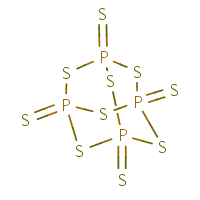Phosphorus pentasulfide
Agent Name
Phosphorus pentasulfide
CAS Number
1314-80-3
Formula
P2-S5
Major Category
Other Classes

Synonyms
Diphosphorus pentasulfide; Pentasulfure de phosphore [French]; Phosphoric sulfide; Phosphorus pentasulfide (P4S10); Phosphorus persulfide; Phosphorus sulfide (P2S5); Sirnik fosforecny [Czech]; Sulfur phosphide; Tetraphosphorus decasulfide; Thiophosphoric anhydride; Diphosphorus pentasulphide; [ChemIDplus] Phosphorus(V) sulfide; [Honeywell MSDS] UN1340
Category
Phosphorus Compounds
Description
Greenish-gray to yellow, crystalline solid with an odor of rotten eggs; [NIOSH] Deliquescent; [HSDB] Yellow solid with an unpleasant odor; [Honeywell MSDS]
Sources/Uses
Used to make lubricant additives, insecticides, matches, and other organic chemicals; [ACGIH]
Comments
Hepatic and renal failure are prominent in deaths due to acute phosphorus poisoning. Eye and respiratory irritation occur due to the hydrolysis products hydrogen sulfide and phosphoric acid. The TLV and STEL recommended correspond to those of phosphoric acid. [ACGIH] If left on clothing, can cause reddening of skin; [CHRIS] Corrosive to eyes; A severe skin and respiratory tract irritant; [ICSC] A lachrymator; [CHEMINFO] Reacts violently with water evolving toxic and flammable gases that may spontaneously ignite; A skin and strong eye irritant; Harmful by ingestion; [Honeywell MSDS]
Biomedical References
Exposure Assessment
Skin Designation (ACGIH)
Insufficient data
TIH
Yes
TLV (ACGIH)
1 mg/m3
Dangerous When Wet
Yes
STEL (ACGIH)
3 mg/m3
PEL (OSHA)
1 mg/m3
IDLH (NIOSH)
250 mg/m3
Excerpts from Documentation for IDLHs
Phosphorus pentasulfide (P2S5) rapidly hydrolyzes to hydrogen sulfide (H2S) and phosphoric acid on contact with water or with moisture present in the air [ACGIH 1991].
Odor Threshold Low
0.0047 ppm
Explanatory Notes
An odor threshold of 0.0047 ppm for phosphorus pentasulfide has been reported. [ACGIH] Vapor pressure = 1 mm Hg at 300 deg C; [Sigma-Aldrich MSDS] Not TIH in land-based spills, but TiH substance released when spilled in water; [ERG 2016]
NFPA
must be preheated
Adverse Effects
Lachrymator
Yes
Toxic Pneumonitis
Yes
Hepatotoxin
Hepatoxic (a) from occupational exposure (secondary effect) or (b) in animal studies or in humans after ingestion
Nephrotoxin
Yes
Diseases, Processes, and Activities Linked to This Agent
Diseases
Occupational diseases associated with exposure to this agent:
Processes
Industrial Processes with risk of exposure: